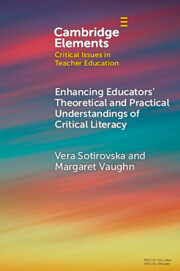Element contents
Enhancing Educators' Theoretical and Practical Understandings of Critical Literacy
Published online by Cambridge University Press: 12 August 2023
Summary
Keywords
- Type
- Element
- Information
- Online ISBN: 9781009304726Publisher: Cambridge University PressPrint publication: 07 September 2023
References
- 4
- Cited by



